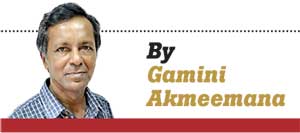
DAILY MIRROR-22 AUGUST: This country has had no shortage of divisive public issues over the years. But, of all the bitterly fought media wars, the controversy over the Wilpattu National Park is easily one of the most savage and divisive. Not being limited to an environmental issue, it divided people along clear-cut ethnic and religious lines, and the controversy rages on and on.
“Wilpattu – Boruwa saha Sebewa” (Wilpattu – truth and lies) is a book by environmentalist Thilak Kariyasawam and Rekha Nilukshi Herath, an investigative journalist of the Ravaya newspaper. In this meticulously detailed and superbly illustrated work, they proceed to demolish the myths and establish some salient facts about the national park, the alleged illegal settlements and history of the area.
Wilpattu became such a fight-to-the death issue mainly because of ethnic and religious insensitivity, amid wild and heated claims that Muslims are being illegally settled within the national park. That many of these settlers had already lived in these areas before being summarily expelled by the LTTE as part of their ‘ethnic cleansing’ was completely ignored.
The myth that Muslims are quietly infiltrating part of the ‘Sinhala land’ is still being perpetrated (while destroying invaluable environmental heritage to boot) and has an international band of followers in countries as far away as South Korea.

Supplemented by extensive research done by Thilak Kariyawasam, Nilukshi Herath has expanded a series of newspaper articles into 181-page book. Among our national parks, Wilpattu suffered most from the civil war, suffering LTTE attacks which forced two lengthy closures and destruction of its wildlife department property as well as large tracts of jungle caused by illegal timber trading. But, once the war ended and Wilpattu was re-opened to the public in 2010, the environmental damage was seen as solely caused by illegal Muslim settlers making settlements on the sly. The media and a ‘star’ cast of environmentalists, religious (mainly Buddhist) dignitaries, political, business and academic figures who formed a powerful Wilpattu lobby simply ignored the fact that some of these settlers had deeds going back to the 1920s.
-
It becomes clear that it wasn’t the environment but ethnic and religious bigotry which turned Wilpattu into such a sacred cow. The settlers were Muslims. The controversial settlements were situated in the national park’s periphery, not within its boundaries
-
Then there is a new Sinhala settlement at Pukkulam, which is within the Wilpattu boundary. But no one has so far protested against that
The ensuing uproar caused untold damage to ethnic harmony. Ignored too, was the fact that the Rajapaksa regime, working together with the army, had created a number of Sinhala-Buddhist-only village settlements in the Wilpattu area. The settlement of Bogasweva, consisting of five villages situated within the boundaries of Vavuniya and Anuradhapura districts, and created by carving out part of the Karuvalangkalikulam (Vavuniya) and Padaviya (A’pura District) forest reserves, is one example. Over 3000 hectares of protected forest were cleared to make way for this settlement.
The book questions why Wilpattu alone became such a hot topic while Bogasweva was ignored by the media, adding that the clearing was initiated in 2012 by MP Namal Rajapaksa who warned forest conservation officials to keep out till the work was completed. Incidentally, the name Karuvalangkalikulam is derived from karuvala, or ebony tree, for which this reserve was famous.
It becomes clear that it wasn’t the environment but ethnic and religious bigotry which turned Wilpattu into such a sacred cow.
The settlers were Muslims. The controversial settlements were situated in the national park’s periphery, not within its boundaries. The book dispels another myth – that Muslim settlers’ houses were built with money from Arab countries. At Kayakuli and Payakuli, there are signboards in situ indicating project aid from India and the European Union. Then there is a new Sinhala settlement at Pukkulam, which is within the Wilpattu boundary. But no one has so far protested against that.
“Wilpattu – Boruwa saha Sebewa” (Wilpattu – truth and lies) is a book by environmentalist Thilak Kariyasawam and Rekha Nilukshi Herath, an investigative journalist of the Ravaya newspaper”
Then there are myriad peripheral issues, such as cashewnut cultivation within reserve areas. Kondachchy near Mannar with over 1000 acres cleared for cultivation is given as an example. Such cultivation is carried out under the Civil Defence Department, too (the book carries photographs as proof). Apart from being a comprehensive record of the Wilpattu saga and the ensuing environmental and media wars, the book provides a fascinating overview of the entire region’s history, culture and folklore.
